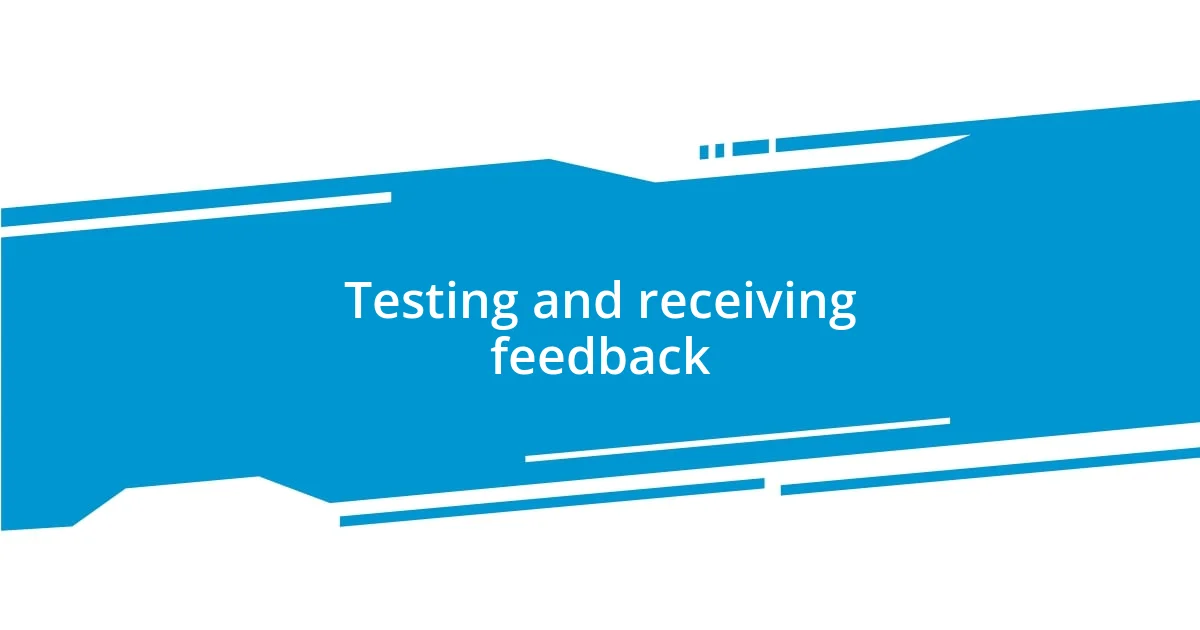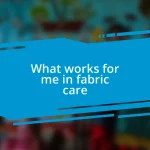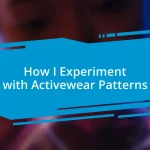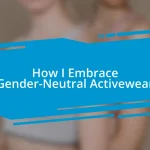Key takeaways:
- The design motivation stemmed from a personal fitness journey, focusing on comfort, style, inclusivity, and empowerment in activewear.
- Engaging with the target audience through feedback helped identify essential needs like comfort, versatility, and breathability in activewear design.
- The production phase emphasized the importance of communication and sustainable practices, ensuring that the final product aligned with the designer’s values and vision.

My motivation for activewear design
From my own journey in fitness, I discovered that wearing the right activewear can truly influence performance. I remember a time when I struggled to find pieces that not only fit well but also made me feel empowered during my workouts. It almost seems like my motivation stemmed from this realization: why should comfort and style be so hard to achieve?
As I ventured into designing my own activewear, I found myself reflecting on the moments I felt most alive—like that exhilarating morning run when the wind kissed my skin, and my favorite leggings didn’t chafe or restrict me. That feeling of freedom ignited my passion and drove me to create pieces that would replicate that same joy for others. Isn’t it fascinating how clothing can impact not just our physical activities, but also our mental state?
Ultimately, my motivation is deeply rooted in a desire for inclusivity and expression. I wanted to ensure that everyone, regardless of body type or style preference, could find something that resonated with them. Isn’t it vital that we all feel seen and celebrated in our activewear? That’s what fuels my passion for this design journey.

Identifying target audience needs
Identifying the needs of my target audience was an eye-opening phase in my design journey. I took time to engage with fellow fitness enthusiasts through surveys and casual conversations. Hearing their stories and preferences helped me grasp the diverse challenges they faced, from finding sizes that fit to discovering styles that spoke to their personalities.
To truly cater to those needs, I focused on key areas that emerged from our discussions:
- Comfort: Many expressed frustration with seams that irritate during workouts.
- Versatility: A number of people wanted activewear that transitions seamlessly from gym to casual outings.
- Inclusivity: It became clear that options for all body types were essential, which resonated with my own journey.
- Style: Personal expression was a must; folks wanted pieces that made them feel good, not just functionally effective.
- Sustainability: A growing concern among my peers was the environmental impact of their clothing choices.
In my experience, listening and understanding these components amped up my design process. It confirmed that activewear isn’t just about performance; it’s about creating a sense of belonging and comfort. Each piece I develop now carries these insights, aimed at helping wearers not just look good, but feel good as well.

Choosing the right materials
Choosing the right materials for activewear can feel overwhelming, but it’s one of the most crucial decisions I made during my design process. I remember standing in fabric stores, running my fingers over various textiles, trying to envision how they would perform during a high-intensity workout. The right material can make all the difference between feeling held-back and empowered, which I’ve experienced firsthand when my leggings seemed to flow with me while I jogged.
During my research, I learned that different fabrics serve unique purposes. For instance, moisture-wicking materials are essential for keeping sweat at bay, while breathable fabrics ensure comfort during long sessions. I recall one workout where the fabric just didn’t breathe—it was stifling and distracting. That day taught me that prioritizing technical aspects was just as important as the aesthetic of my designs.
To make the decision process easier, I created a comparison of popular activewear materials. This table can help you weigh your options based on key characteristics.
| Material | Properties |
|---|---|
| Polyester | Durable, moisture-wicking, quick-drying |
| Spandex | Flexible, forms to the body, retains shape |
| Nylon | Smooth, breathable, lightweight |
| Merino Wool | Insulating, moisture-wicking, odor-resistant |
| Bamboo | Soft, sustainable, antibacterial |

Designing for functionality and style
Designing for functionality and style means finding that sweet spot where aesthetics meet practicality. I remember sketching designs late into the night, always considering how each piece would perform during a workout. Would my top stay in place during a sprint? Would the pants be comfortable enough for yoga? These questions shaped my designs and ensured that every stitch had a purpose, blending performance-enhancing features with visual appeal.
Creating versatile pieces that transition effortlessly from workout to social settings became a personal mission. When I selected a design that allowed for a subtle, stylish look while remaining completely functional, I felt a rush of excitement. Picture this: wearing a sleek jumpsuit that moves with you during a high-intensity session yet looks perfectly polished for brunch with friends. That’s the kind of duality I aimed for, something that encourages wearers to express their style without compromising on comfort or functionality.
One lesson I learned is that style can elevate confidence. I still remember slipping into my first prototype—a vibrant sports bra and matching leggings. As I admired myself in the mirror, I felt fierce and ready to conquer my workout. That moment reinforced my belief: effective activewear must not only perform but also make you feel empowered. So, I constantly ask myself, “How can I inspire others to feel this way?” and let that question guide my design choices.

Creating prototypes and samples
Once I settled on the materials, it was time to craft prototypes and samples. I remember the excitement I felt as I cut the first pieces, bringing my designs to life for the very first time. The initial prototypes were far from perfect—some seams were off, and the fit was a bit loose in places—but there was something magical about seeing my vision take shape. It’s amazing how a piece of fabric can transform into something that you originally only imagined in your sketches.
Testing the samples was a crucial step in my process. I eagerly wore each prototype during my workouts, observing how they moved with my body. On one particularly intense run, I noticed my original design had some sticking points—literally! The seams rubbed against my skin, reminding me that comfort is paramount. I found myself asking, “How can I make tweaks to enhance the experience?” Feedback from these sessions became my guiding star, leading to improvements that made every piece more functional and enjoyable.
Eventually, final samples emerged that reflected my journey of trial and error. I recall feeling a profound sense of achievement when I invited friends to try them on. Their enthusiasm lit up the room as they danced around, testing the flexibility and fit of each piece. Seeing their joy reinforced that these prototypes were not just clothing; they resonated with the spirit of empowerment that I aimed to capture. It really made me think—what does it mean to design pieces that people genuinely love to wear? That curiosity drove me to refine my concept even further, ensuring I created activewear that truly resonated with others.

Testing and receiving feedback
Testing my designs was like opening a door to a whole new world. After finalizing my samples, I decided to put them through their paces at a local community yoga class. As I transitioned from downward dog to warrior pose, I found myself battling discomfort from a tight waistband. It hit me—what good is a design if it hinders your flow? I started jotting down notes, eager to identify what tweaks I could make to elevate the experience.
After my yoga session, I scheduled a small gathering with a few close friends for an informal feedback session. Watching them try on my creations was exhilarating! I felt a mix of pride and nervousness. The moment they slipped into my designs, their faces lit up; that initial joy was contagious. However, I didn’t shy away from asking about the fit, the feel, and any quirks they noticed. Their genuine feedback, cool and candid, helped me understand elements I had missed—like the importance of using softer seams to prevent chafing during extended workouts.
One particularly insightful comment came from a friend who does CrossFit. As she lifted weights while wearing one of my tops, she pointed out the need for more breathability in the fabric. Her feedback prompted a deep dive into materials that would keep wearers cool under pressure. Reflecting on these experiences made me realize how essential it is to listen closely to user feedback. It wasn’t just about my vision, but about creating pieces that catered to real athletes’ needs. Wouldn’t you agree that understanding your audience can revolutionize your design approach?

Finalizing the design for production
Finalizing the design for production felt like standing at the edge of a cliff, ready to leap into the unknown. I meticulously reviewed every detail, from the stitching to the color choices. There was a moment when I gazed at my samples and wondered, “Will this translate well in production?” It was critical that the essence of my designs carried forward, so I enlisted the help of a small production team experienced in activewear.
As we moved into the production phase, I learned just how vital communication was. I remember sitting at a table, surrounded by fabric swatches and technical sketches, collaborating with my production partner. We discussed everything from production timelines to sustainable practices, such as sourcing eco-friendly materials. I felt my heart radiate with purpose—this wasn’t just a business decision; it was about creating a brand that truly aligned with my values.
The day the finalized designs were sent to production was a mix of exhilaration and anxiety. I distinctly recall taking a deep breath and whispering to myself, “This is it!” It dawned on me that I was not only creating activewear; I was crafting an experience for those who would wear them. I found myself asking again, “Will my designs inspire others?” That question fueled my passion throughout the entire process, and I hoped my finished pieces would ignite a sense of confidence in anyone who donned them.
















